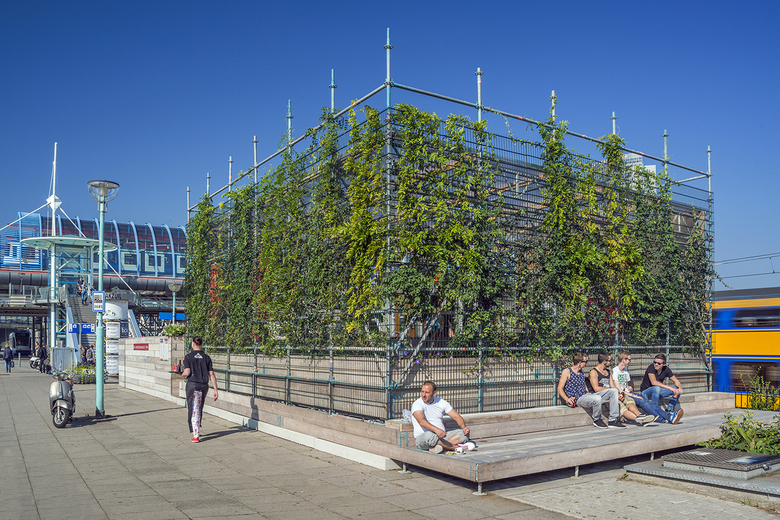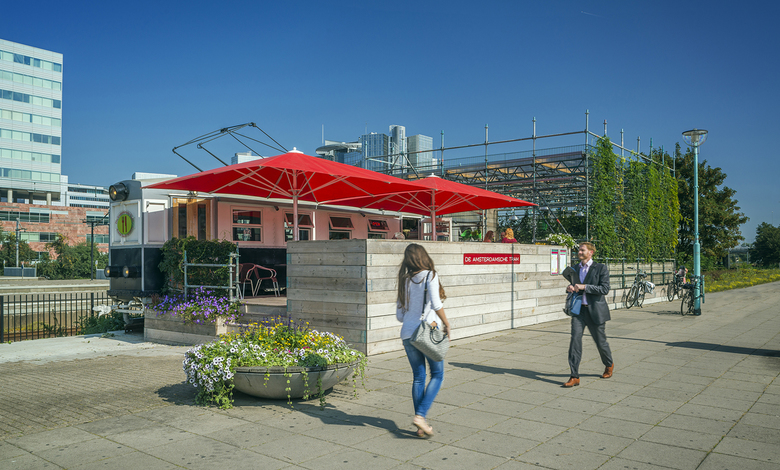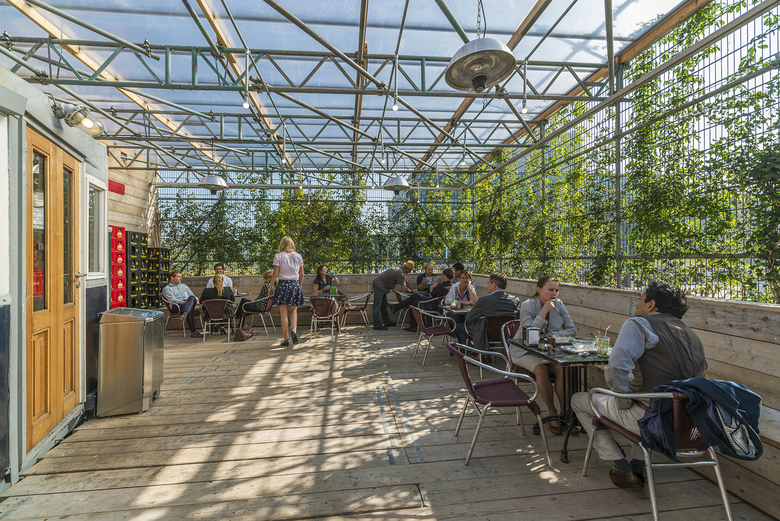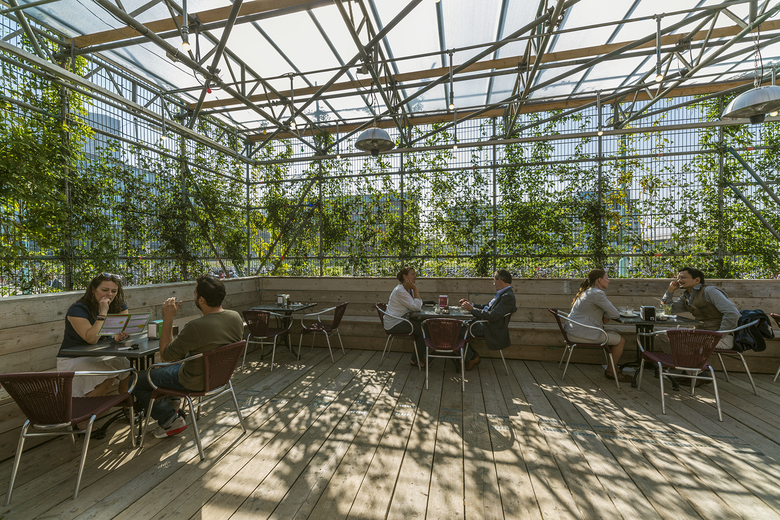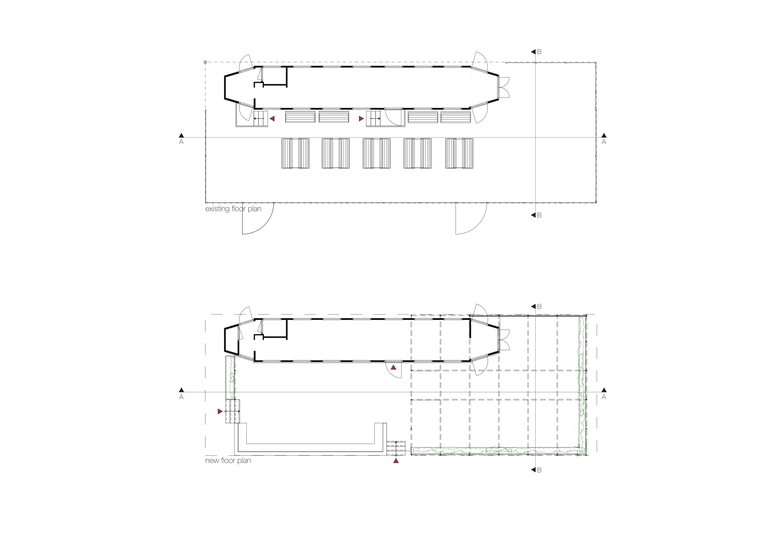cc-studio
Amsterdamsche Tram
cc-studio
16. July 2015
Photo: John Lewis Marshall
Cc-studio was invited, together with two other offices, to take part in a mini-competition initiated by the municipal supervisor Don Murphy, the director of VMX architects.
The aim was to find a common ground between the client, the (frustrated) owner of the small lunchroom situated in an old tram and the municipality, owner of the ground surrounding train station Amsterdam- Sloterdijk.
Photo: John Lewis Marshall
The client’s lunchroom is located on a rather desolated southeast corner, lost in a sea of large office buildings and parked bicycles. This public space does not entice the public to stay and linger, adding to a feeling of emptiness. Running a small business in such a place is difficult and to make it harder the tram only accommodates 15 seats inside. The main source of income came from the 40 seats on the outside terrace. Other than the view, the unreliable Dutch weather (cold and rain) and windy conditions of the unprotected plot caused problems. The client’s logical wish was to do something about these conditions. A protected space would mean longer use of the facilities and the possibility of renting out the space outside of the regular opening hours and in the weekends, when all the offices are close, for special events.
Photo: John Lewis Marshall
The client tried getting a permit to place an enclose space in front of the tram. When that didn’t work he tried proposing a canopy. Months passed and he was getting nowhere. Yet closing his business would be a lose-lose situation not only for the client but also for the municipality because creating a more human-friendly environment in that area is also in their best interest. The council wanted a high quality solution, but had no means of their own to back them. The client couldn’t take such a risk and wanted to invest at the utmost 12,500 euro – the price of the large sunscreen.
A Catch 22 and in face of such a brief, the two other offices backed out of the offer.
Photo: John Lewis Marshall
To make the design of a terrace and a covered space on a extremely tight budget happen, cc- studio used the financial crisis to their advantage. The fact that many contractors went out of business meant that used scaffolding at bargain prices was flooding the market. Using scaffolding as the primary construction material mostly solved the financial issue. Cc-studio then took up the challenge of building the entire project out of the reclaimed material.
Photo: John Lewis Marshall
The realized intervention works on both urban-space level as well as on the more detailed building level. By lifting the terrace up by 0.5m using used scaffolding and reclaimed wooden planks giving it a wind protective barrier integrated with a bench, a 35m2 platform was created. This made the demarcation between the passersby and lunch room clients clearer, giving the latter an overview of the area. Also eliminating the height difference between the terrace and the tram removed an important psychological barrier for people to enter the lunchroom and made it easier for the staff to work the terrace.
Photo: John Lewis Marshall
The second intervention was the creation, again using used scaffolding material and reclaimed wood, of a 70m2 covered space in front of the tram, leaving it visible to the public eye from the most important vantage points in and around the station. The transparent polycarbonate roofing gives the space protection from the wind and rain. By using an open steel mesh for plants to grow into, both the municipal requirement of openness and the clients wish for wind protection (and in the summer, from the sun) could be fulfilled at very low costs.
The addition of greenery at that spot fits into the urban plan of the area. The green veil also filters the view from within to the surrounding offices, giving the harsh environment a softer feel and making it a nicer place to stay a bit longer.
Photo: John Lewis Marshall
Needless to say, no local builder accepted to take on this project and to prove their wrong the studio took on the challenge to build it. Thanks to help of the scaffolding company Dutch Steiger and a network of independent craftsmen, including studio members, it was built. The whole design and built was realized within a period of three months. In the end, the entire project was designed and built for the price of an average family car.
Photo: John Lewis Marshall
PROJECT CREDITS
Architect: cc-studio
Project team: Danny van Kessel, Gerald Lindner, Anke van Looveren
Contractors: Dutch Steigers, cc-studio
Builders: Dutch Steigers, Thijs Wolthuis, Danny van Kessel
Structural engineer: cc-studio
Plant advice: PlantenTuin Esveld
Photography: John Lewis Marshall
Site plan (Drawing: cc-studio)
Floor plans (Drawing: cc-studio)
Building sections (Drawing: cc-studio)
Elevations (Drawing: cc-studio)
Elevations (Drawing: cc-studio)
Related articles
-
For the Workforce and Tenants – and Citizens
on 6/12/23
-
The Looking Glass
on 12/13/19
-
Vertical Lofts
on 7/2/19
-
Amsterdamsche Tram
on 7/16/15
